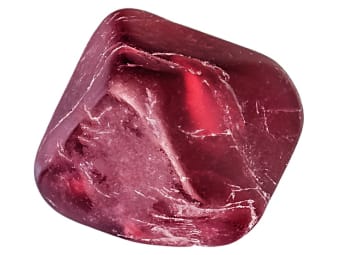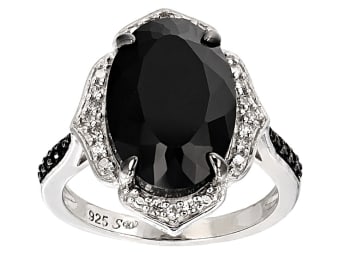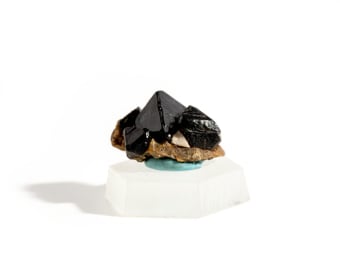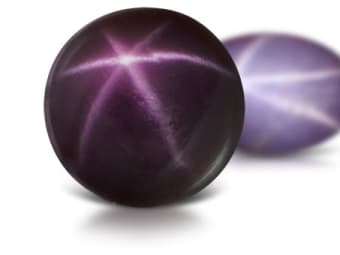Famous catalog entrepreneur J. Peterman said, "People want things that are hard to find...things that have romance about them." In the world of gemstones, that means rarity and beauty, and to so many lovers of gemstones, the finest combination of those two things can only be spinel.
"Fine spinel is one of the best stories never told," gem expert and Vault buyer, Jay Boyle says. "Why was spinel's story never told? Because it was one of the first synthetics made at the turn of the century, for class rings and other uses. 'Spinel' became synonymous with 'synthetic'. Natural spinel was so rare that the world had never heard of it."
"Spinel is one of the best-kept secrets for avid gem lovers and collectors," gem expert Vault buyer, Shawn O'Sullivan says. "I really fell in love with spinel when I came to work with JTV, mainly due to experiencing the wide range of colors and the depth of beauty this gem holds. I always knew JB (Vault buyer Jay Boyle) had a true passion for this gem, but it was not until I travelled to Vietnam and bought a small lot of spinel that it really hit me. Spinel has the ability to impact you to the core!"
Red spinel, in particular, has the potential to truly touch its beholder. "The 'ruby red' spinel is extraordinarily rare and almost unobtainable. In my own career I have seen only two," says Richard Wise, G.G., in his book Secrets of the Gem Trade: The Connoisseur's Guide to Precious Gemstones. "True reds," he continues, "...are without question the rarest and most sought after of all spinel."
Spinel 101
Spinel is one of the few gemstones that require no special treatment. Its beautiful, vivid colors and very good clarity are entirely natural, so spinel is almost always untreated. In addition to fine color and clarity is spinel's rarity, which is even greater than that of ruby. Plus only a handful of stones are as durable as spinel, and it has very good hardness of 8.
Unfortunately, naturally beautiful spinel has suffered as a result of its own beauty and rarity. Because of spinel's vibrant red, it is often considered a substitute for ruby. Ironically, fine spinel is rarer than the ruby it "imitates" but is usually less expensive. And because spinel is so rare, it has hardly had a chance to become popular. That lack of demand has kept the price low, and its affordability has led to the misconception that spinel isn't as valuable as it truly is.
Another reason spinel has often been substituted (and mistaken) for ruby could be because spinel is an indicator gem for ruby. When a gem miner finds spinel, he knows ruby is close by. It's fairly easy for a trained eye to tell the crystals apart, though, especially if the crystal's original shape hasn't worn away. Spinel grows in octahedral crystals that are so well formed they are called "angel cut" in Burma, implying that the crystals were perfectly cut by angels.
The name "spinel" is believed to come from spina, the Latin word for "thorn," likely chosen because of spinel's angular, double-thorn-shaped crystals. Some believe that the name comes from the Greek word meaning "spark," possibly because of the glow that so many spinel possess. Either way, the modern name "spinel" refers to both an entire group of related minerals and to the specific few that are gem quality.
"Balas ruby," which is another name often given to spinel throughout history, comes from the ancient word for Badakhshan, in honor of the famed Badakhshan mines where so many important spinel were mined. More modern significant sources for spinel include Burma, Sri Lanka, Vietnam, Thailand, and Madagascar, though you might be surprised to know that spinel has also been found in the United States in New Jersey, as well as in Australia, Brazil, Nepal, Tajikistan, and Nigeria. "Now we are seeing some outstanding pieces coming out of Tanzania that are truly one-of-a-kind," says expert high-end Vault buyer, Shawn O'Sullivan, "But whether they are from Sri Lanka, Burma, Tanzania, or Madagascar, holding a fine spinel in your hand will make you see why it is one of the most sought after gems on the planet."
Spinel is a type II gemstone, so it's understood that most spinel will have minor inclusions, but they don't distract from the stone's beauty.That value and rarity increases exponentially when you consider matched spinel pairs, because to perfectly match two or more stones in a species that boasts more hues than any other is incredibly difficult. JTV Gemstone Expert Jay Boyle says matched spinel pairs are "truly remarkable in their perfection of color and matching, purity, intensity, beauty, and cut," making them the "best collection of matched pairs of spinel on Earth." When it comes to matched spinel pairs, he says, "Bigger is more rare and desirable, but even the smallest pairs are a terrific combination of extremely rare material--top gem quality at very affordable prices that are hugely undervalued and not replaceable at two or even three times the price."
While well-matched spinel pairs are hundreds of times more rare than singles, a suite is infinitely rarer. It can take literally dozens of years of collecting to gather enough stones to make a spinel suite. According to O'Sullivan, in order to create a spinel suite, a collector would have to buy spinel in the desired color, cut it to a particular size, and then wait... collect more, cut it, and wait... repeat the process... and wait for more.

Color, Color, Color
It's hard to write about spinel and not focus on the color. In fact, much of this article (outside of this section) also touches on spinel's spectacular color. But all colored gems are spectacular, right? "Because of its wide color range, spinel is often compared to many other gems," O'Sullivan says. "But there really is no gem like it."
"Spinel is finally getting the attention it deserves," says Boyle. "Why is it finally getting that attention? Intense colors--intense fluorescent colors. Spinel is a colored stone that's all about the color. The reds, oranges, flame reds, orange reds, pinks, purples, cobalt blues--all of these colors are best of breed in spinel," says Boyle. "The colors don't get any better than these in any other gem species. In fact, the best spinel in any color beats the best color in any other gem species. Color, color, color! In real estate, it's 'location, location, location'. In colored gems, it's color, color, color."
"When you think of the most expensive gems on Earth, what comes to mind? Top red Burmese rubies, top blue and yellow sapphire, top blue and blue-green Paraiba tourmaline, top green Colombian emeralds--we think nothing compares to those colors. But spinel has top color in all of those colors and more--spinel wins in every category," Boyle proclaims. "The prettiest red stones on Earth are spinel. The prettiest pink stones on Earth are spinel. The prettiest orange stones on Earth are spinel--though that's so rare you almost never see it. The prettiest blue, the prettiest purple...all spinel." Spinel features top colors that trump the top colors of every other gemstone, all in one species.
Spinel's rich colors require passionate adjectives to describe them. You can't fully explain a spinel's appearance without using exciting words like electric, fluorescent, neon, vibrant, juicy, hot, and intense. Colorful language to describe a colorful stone, for sure--but what causes these exciting colors in spinel?
Natural hot pink, pinkish-red, and red Burmese spinel exhibits strong reddish-orange fluorescence when exposed to UV light. These stones would "glow like burning coals," Boyle says, in a dark room under black light. This fluorescence contributes to Burmese spinel's intensity of color, because the presence of UV light in daylight causes them to fluoresce--to literally glow--in daylight. That inner glow serves to electrify their color to an even more vivid, almost-neon status. That might explain why wearing a flame-red spinel will make you look--and feel--like you're giving off sparks.
In addition to the phenomenon of fluorescence in some spinel, the actual color in a spinel is also inherently different than in other gems because spinel is singly refractive. That means to your eye, whatever color you see when looking at spinel will be more pure because it's a single ray of a single hue, not mixed hues. Ruby's reds are a mix of two colors--violet red, orange red, purplish red. The same is true of sapphire; a blue sapphire can exhibit slightly greenish or reddish/purple hues in addition to the blue. But when you look at a spinel with great color, that color is the only one you see--it's not one color beam that's been split into two--and that makes it appear more potent, more vivid. Single refractivity allows a stone's intense color to be more pure and intense than if it were a doubly refractive stone like ruby, sapphire, tanzanite, tourmaline, etc. "That one vivid bright color rushes out of the stone and almost assaults your senses," Boyle says. "When you've had that experience, you'll remember and know what a great gem is for the rest of your life, and you'll begin to compare the rest of your gem collection with a fine red spinel or a fine blue spinel. It will become your guidepost of what a great color can be."
I have spent a great deal of time discussing red spinel, yet spinel actually comes in every color of the rainbow. Its palette is truly exceptional. There are even colorless and black varieties of spinel. In the gem trade, the bright lively reds and cobalt blues garner the highest prices.
In addition to color, spinel has other special characteristics. In rare cases, spinel may exhibit phenomena. Star and color-change spinels are highly prized by gemstone collectors. Stars may have four or six rays, depending upon the orientation of the cut.

Everyone Loves Spinel
"For years, I've done an informal survey, asking gem dealers, 'What's your favorite gemstone?'. People ask me all the time, and I ask others--everyone wants to know what the experts' favorites are," Boyle says. "The results of my unofficial survey--of experts, gem connoisseurs, world-class gem dealers, whatever you want to call them--they all say spinel is their favorite gemstone."
"Almost all colored stone dealers will tell you, it's spinel. What do the dealers know? They arguably have the most refined eye and highly developed senses trained to appreciate colored stones. They spend decades making choices based on slight differences in color. You can't be a dealer without having a very fine eye for color and being attuned to subtle differences and nuances in color.

Durable Spinel: Jewelry and Crystals
Spinels are also excellent for use in jewelry because they are hard, tough, and more affordable than ruby or sapphire. Unfortunately, the supply of spinel limits most mass-market jewelry to smaller stones. Larger, cleaner goods are in short supply and often set in one-of-a-kind pieces.
Spinel is also prized by mineral collectors for its well-formed octahedral crystals. In rare cases, a lucky collector might even run across a fully formed cube or dodecahedron.
Spinel in History
Spinel has only been recognized as such since around 1850. Before that, spinel--actually, almost all red stones--were called rubies, because early gemology classified stones simply by color. Consequently, spinel has an unclear and unfortunately limited history. Many of the world's historically famous "rubies" are actually ruby-red spinel, including the estimated 170-carat Black Prince's Ruby, currently set in the Imperial Crown of England.
The Black Prince's Ruby has an amazing history filled with enough treachery, danger, and deceit to rival that of the legendary, supposedly cursed, Hope Diamond. While most people realize that the stone is actually a bright red spinel, not a ruby, its size and its history might surprise you.
The semi-polished stone is said to be "bead shaped," though it actually appears to be an octahedron or diamond-shaped, like a slightly distorted square turned on end. Measuring about 2 inches high and nearly that much wide, it weighs an estimated 170 carats and is said to be about the size of a chicken egg.
The Black Prince's Ruby is backed by gold foil, as most ancient gems were, and was drilled at one end to be worn on a necklace at some time during its history. Today that drill hole is covered by a small ruby, which looks like a bubble in photographs of the stone.
Now for the treachery, danger, and deceit. While the stone was probably mined in the famous balas ruby mines (spinel is an indicator stone for ruby) in Badakhshan near the Afghan border, its torrid history is recorded back to 1366, when it was stolen from the lifeless body of Moorish prince Abu Said by Don Pedro of Castile. A year later, the evil Don Pedro used the stone--willingly or unwillingly--as payment to the Black Prince, Edward of Woodstock, for help against a revolt by Don Pedro's own brother.
A gap in its history leads to 1415, when the stone was nearly destroyed during the Battle of Agincourt while being worn in Henry V's gem-encrusted battle helmet.
Legend credits the spinel with saving Henry V's life by deflecting a blow while it adorned his battle helmet, and the notorious gem was passed down through several British kings over the next two hundred years until it was set in England's state crown by James I. In the mid 1600s, the Crown Jewels were disassembled and sold, and the Black Prince's Ruby is said to have been bought by a British jeweler for the modern-day equivalent of about $8. Fortunately he later returned it to the monarchy and it was set into Charles II's state crown.
The poor spinel has faced danger at least three times since then: once when nearly stolen by a rascal named Colonel Blood; once in a Tower fire in 1841 though saved by a brave police inspector; and once again during WWII in an attack by German bombers.
The Black Prince's Ruby is currently set in England's Imperial State Crown just above the 317.40-carat Cullinan II diamond and is now safely on display--hopefully--in the Tower of London.
Another historically famous spinel is the also-misnamed Timur Ruby, now featured in Queen Elizabeth's crown and weighing more than 350 carats. Lending it an incredible, undeniable provenance, the Timur Ruby is engraved with Persian names of the emperors who owned it.
Those famous spinels were probably mined in the legendary Badakhshan mines, likely located on the present-day border of Afghanistan and Tajikistan and the source of many large, fine spinel between 1000 and 1900 AD. There are no definitive records about the Badakhshan mines, other than the numerous legends about the gems it yielded. One such stone, the Samarian Spinel--the world's largest spinel, weighing 500 carats and measuring over 2 inches in width--is believed to have adorned the neck of the Biblical golden calf. It is now part of the Iranian crown jewels.

Separating Spinel and Corundum
It isn't difficult for a gemologist to differentiate between spinel and ruby or sapphire. Spinel may look like corundum, but it has different chemical, optical, and physical properties. Spinel is not as hard or as dense as corundum. It also has many other distinct characteristics. The most notable difference between the two is crystal structure. Spinel belongs to the cubic system and, unlike corundum, is singly refractive. The fastest and easiest way to separate the two gems is by looking for double refraction or its absence.
Chemically, spinel is a magnesium aluminum oxide, its chemical formula represented as MgAl2O4. Nature rarely creates anything quite that pure, however, and many other elements are often present in varying amounts, creating a wider range of values for many of spinel's properties. Iron, manganese, and zinc are the most common replacements for magnesium.

The Spinel Market
- "Spinel is just now gaining its rightful place, where it should be, in terms of its beauty, durability, and rarity, and this process of spinel being elevated in value is far from over--it has just begun," Boyle says.
"I've been in love with spinel ever since I started in the business," he says. "It was the first gem I personally understood. Then for years, I couldn't understand why the market didn't appreciate it, but the fact of the matter is it was just too rare." In those days, Boyle said, there wasn't enough supply to make a market for spinel. But then, beginning with the Swiss, thanks to Swiss gem buyers who loved and appreciated spinel and saw how it was undervalued, spinel's popularity started to grow. European dealers, who are usually far more sophisticated in gem dealings than those in the rest of the world, started to promote spinel around 2000. A book was written about spinel, allowing more people than ever to learn more about the mysterious stone most of them had never heard of.
Next, Boyle says, the French fell in love with spinel, then the Germans... Soon there was a dislocated market for spinel, because it was still very affordable in Thailand and Burma but had become very expensive in countries that had caught on to it earlier. Then fine Tanzanian and Sri Lankan stones came to market, and the prices started to go up everywhere.
"As early as 2000, on a trip to Bangkok, I bought an amazingly beautiful, slightly orange-red spinel--flame red with just a little orange, fire engine red--for $500 per carat and immediately resold it for $600 a carat," Boyle says. "I'd done well, but today, that stone would be over $3,000 a carat. In fact, I saw stones similar to it in April 2007 at the Basel show in Switzerland selling for $4,000 to $5,000 per carat. And this isn't just fine flame reds--it's hot pink, hot reddish pink. It's going just like Paraiba (tourmaline) did, when it started to move."
"At Basel last year, I asked (a dealer friend) why the price of spinel had gone crazy. He said spinel is the next Paraiba tourmaline, because the color has that intensity, that internal glow," Boyle says. He has said more than once that when Paraiba first came onto the marketplace in Hong Kong in 1989, it was selling for $600 per carat, which he thought was too high. He'd never seen tourmaline sell for more than $250 to $300 per carat. "I was wrong," he says now, "$600 a carat wasn't a high price--top Paraiba can now be $30,000 a carat. So is this the top for spinel? I don't think so. I think it's just the beginning of the world falling in love with one of the finest gemstones on the planet."
The value and rarity increases exponentially when you consider matched spinel pairs, because to perfectly match two or more stones in a species that boasts more hues than any other is incredibly difficult. Gemstone Expert and JTV buyer Jay Boyle says that when it comes to matched spinel pairs that "bigger is more rare and desirable, but even the smallest pairs are a terrific combination of extremely rare material."
So where can spinel go in terms of price? Paraiba tourmaline might be a good indicator. The top colors in spinel are just as rare, yet they are still moderately priced. Top spinel is just now becoming appreciated by the masses, thanks to television and the Internet, and this will drive the prices significantly upward over the next few years.
And what causes that price? It all comes back to the color. "Why does a red spinel cost three, four, five thousand a carat and a red garnet a few dollars a carat? The reds, side by side, are similar only in name," Boyle says. "Spinel has an inner light, an intensity, a lit-from-within glow that no other red gem has." That's why we love spinel.

References
Wise, Richard W., G.G. Secrets of the Gem Trade: The Connoisseur's Guide to Precious Gemstones. Brunswick House Press, 2006
